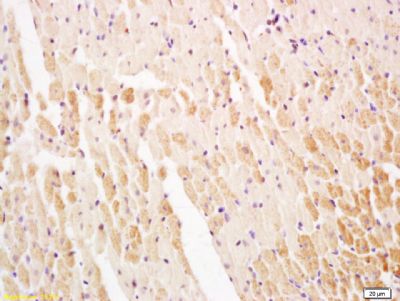ATP dependent calcium pumps are responsible, in part, for the maintenance of low cytoplasmic free calcium concentrations. The ATP pumps that reside in intracellular organelles are encoded by a family of structurally related enzymes, termed the sarcoplasmic or endoplasmic reticulum calcium (SERCA) ATPases. The SERCA1 gene is exclusively expressed in type II (fast) skeletal muscle. The SERCA2 gene is subject to tissue dependent processing which is responsible for the generation of SERCA2a muscle-specific form expressed in type I (slow) skeletal, cardiac and smooth muscle and the SERCA2b isoform expressed in all cell types. The SERCA3 gene is not as well characterized and is found in non-muscle cells.
Function:
This magnesium-dependent enzyme catalyzes the hydrolysis of ATP coupled with the translocation of calcium from the cytosol to the sarcoplasmic reticulum lumen. Isoform 2 is involved in the regulation of the contraction/relaxation cycle.
Subunit:
Associated with phospholamban (PLN) (By similarity). Isoform 1 interacts with TRAM2 (via SLCterminus). Interacts with HAX1.
Subcellular Location:
Endoplasmic reticulum membrane; Multi-pass membrane protein. Sarcoplasmic reticulum membrane; Multi-pass membrane protein.
Tissue Specificity:
Isoform 1 is widely expressed in smooth muscle and nonmuscle tissues such as in adult skin epidermis, with highest expression in liver, pancreas and lung, and intermediate expression in brain, kidney and placenta. Also expressed at lower levels in heart and skeletal muscle. Isoforms 2 and 3 are highly expressed in the heart and slow twitch skeletal muscle. Expression of isoform 3 is predominantly restricted to cardiomyocytes and in close proximity to the sarcolemma. Both isoforms are mildly expressed in lung, kidney, liver, pancreas and placenta. Expression of isoform 3 is amplified during monocytic differentiation and also observed in the fetal heart.
Post-translational modifications:
Nitrated under oxidative stress. Nitration on the two tyrosine residues inhibits catalytic activity.
DISEASE:
Defects in ATP2A2 are a cause of acrokeratosis verruciformis (AKV) [MIM:101900]; also known as Hopf disease. AKV is a localized disorder of keratinization, which is inherited as an autosomal dominant trait. Its onset is early in life with multiple flat-topped, flesh-colored papules on the hands and feet, punctuate keratoses on the palms and soles, with varying degrees of nail involvement. The histopathology shows a distinctive pattern of epidermal features with hyperkeratosis, hypergranulosis, and acanthosis together with papillomatosis. These changes are frequently associated with circumscribed elevations of the epidermis that are said to resemble church spires. There are no features of dyskeratosis or acantholysis, the typical findings in lesions of Darier disease.
Defects in ATP2A2 are the cause of Darier disease (DD) [MIM:124200]; also known as Darier-White disease (DAR). DD is an autosomal dominantly inherited skin disorder characterized by loss of adhesion between epidermal cells (acantholysis) and abnormal keratinization. Patients with mild disease may have no more than a few scattered keratotic papules or subtle nail changes, whereas those with severe disease are handicapped by widespread malodorous keratotic plaques. In a few families, neuropsychiatric abnormalities such as mild mental retardation, schizophrenia, bipolar disorder and epilepsy have been reported. Stress, UV exposure, heat, sweat, friction, and oral contraception exacerbate disease symptoms. Prevalence has been estimated at 1 in 50000. Clinical variants of DD include hypertrophic, vesicobullous, hypopigmented, cornifying, zosteriform or linear, acute and comedonal subtypes. Comedonal Darier disease (CDD) is characterized by the coexistence of acne-like comedonal lesions with typical Darier hyperkeratotic papules on light-exposed areas. At histopathologic level, CDD differs from classic DD in the prominent follicular involvement and the presence of greatly elongated dermal villi.
Similarity:
Belongs to the cation transport ATPase (P-type) (TC 3.A.3) family. Type IIA subfamily.
SWISS:
P16615
Gene ID:
488
Database links:
Entrez Gene: 396446 Chicken
Entrez Gene: 403878 Dog
Entrez Gene: 488 Human
Entrez Gene: 11938 Mouse
Entrez Gene: 396875 Pig
Entrez Gene: 100038308 Rabbit
Entrez Gene: 29693 Rat
Omim: 108740 Human
SwissProt: Q03669 Chicken
SwissProt: O46674 Dog
SwissProt: P16615 Human
SwissProt: O55143 Mouse
SwissProt: P11607 Pig
SwissProt: P20647 Rabbit
SwissProt: P11507 Rat
Unigene: 506759 Human
Unigene: 227583 Mouse
Unigene: 2305 Rat
| Picture |
Tissue/cell: rat heart tissue; 4% Paraformaldehyde-fixed and paraffin-embedded;
Antigen retrieval: citrate buffer ( 0.01M, pH 6.0 ), Boiling bathing for 15min; Block endogenous peroxidase by 3% Hydrogen peroxide for 30min; Blocking buffer (normal goat serum,SLC0005) at 37℃ for 20 min;
Incubation: Anti-Serca2/SERCA2 ATPase Polyclonal Antibody, Unconjugated(SL6693R) 1:200, overnight at 4°C, followed by conjugation to the secondary antibody(SP-0023) and DAB(SLC0010) staining
|
|
|
